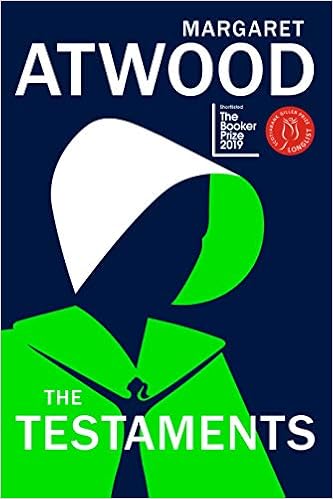Narrated by three women, this novel is set 15 years after the end of The Handmaid’s Tale.
Aunt Lydia, a villain in The
Handmaid’s Tale, secretly writes her memoirs explaining how she became a
founder of the Gilead regime. Agnes is a
young woman who has grown up in Gilead and is being groomed to marry a
Commander. Daisy is a 16-year-old living
in Canada with her very protective parents.
Of course, there are connections among the three, but these are known
only to Aunt Lydia and eventually revealed to the reader – though many may
guess their identities fairly early in the narrative.
It is Aunt Lydia’s voice that is compelling. She is revealed to be more than the
one-dimensional villain she seems in The
Handmaid’s Tale. Her backstory
explains why she became an early collaborator with the Gilead regime. As a founder, she has a statue which she sees
as representing “my idealism, my unflinching commitment to duty, my determination
to move forward despite all obstacles” (3).
This is the woman we recognize, but we also hear about her regret at
having to use physical force: “This
weapon, [a Taser], reminds me of my failings:
had I been more effective, I would not have needed such an implement”
(4). She and three other women become
founders, creating the “laws, uniforms, slogans, hymns, names” (177) that
govern women’s lives in Gilead society; she helps create a system that exploits
and violates women. Aunt Lydia’s feelings
about her role are mixed: “Did I hate
the structure we were concocting? On
some level, yes: it was a betrayal of
everything we’d been taught in our former lives, and of all that we’d
achieved. Was I proud of what we managed
to accomplish, despite the limitations?
Also, on some level, yes. Things
are never simple” (178).
Aunt Lydia is certainly a complex figure. Her intelligence and cunning are
obvious. She knows that even she is not
totally safe because Gilead is rotten at its core, so she works at solidifying
her power by appeasing male egos and devising subtle plots to punish enemies
and gain allies. The extent of her
vengeful nature is foreshadowed: “I will get you back for this. I don’t care how long it takes or how much
shit I have to eat in the meantime, but I will do it” (149). Yet in the end, she asks the reader, “Try not
to think too badly of me, or no more badly than I think of myself” (404).
Aunt Lydia’s voice is so compelling, Daisy and Agnes pale in
comparison. They seem like typical YA
protagonists. Agnes even has the wicked
stepmother who makes her life miserable.
What is interesting is how their very different upbringings have formed
their personalities and attitudes.
Daisy, raised in Canada, is feisty and rebellious whereas Agnes, raised
in Gilead, is meek and obedient. Being
able to wear jeans and a T-shirt makes Daisy “feel more like myself” (364)
while the same attire makes Agnes uncomfortable: “I found the clothing provided for us
disagreeable in the extreme. The
underwear was very different from the plain, sturdy variety . . . it felt
slippery and depraved. Over that were
male garments. It was disturbing to feel
that rough cloth touching the skin of my legs, with no intervening petticoat. Wearing such clothing was gender treachery
and against God’s law” (365).
The commentary about Gilead society – which so often reflects contemporary society –
is interesting. For instance, “The
doctors, the dentists, the lawyers, the accountants: in the new world of Gilead, as in the old,
their sins are frequently forgiven them” (252) and “The ability to concoct
plausible lies is a talent not to be underestimated” (387). Parallels are often emphasized. For example, one cannot but think of the
current migrant crisis when reading, “people were risking their lives walking
north to the Canadian border in winter” (51) and “I hadn’t considered what it
was like to leave a place you knew, and lose everything, and travel into the
unknown. How hollow and dark that must
feel, except for maybe the little glimmer of hope that had allowed you to take
such a chance” (271).
The ending of the novel is more positive than that of The Handmaid’s Tale. Resistance has grown and the regime seems to
be crumbling. The Twelfth Symposium on
Gileadean Studies at the end of The
Handmaid’s Tale indicates that Gilead does fall; The Testaments explains how that fall comes about. The adventure story at the end that helps to
bring about Gilead’s downfall is not the most enjoyable part of the novel; I
found myself having to suspend disbelief.
The Testaments is an
enjoyable read. Of course, it is not as
impactful as The Handmaid’s Tale, but
it would have been foolish to expect otherwise.

No comments:
Post a Comment